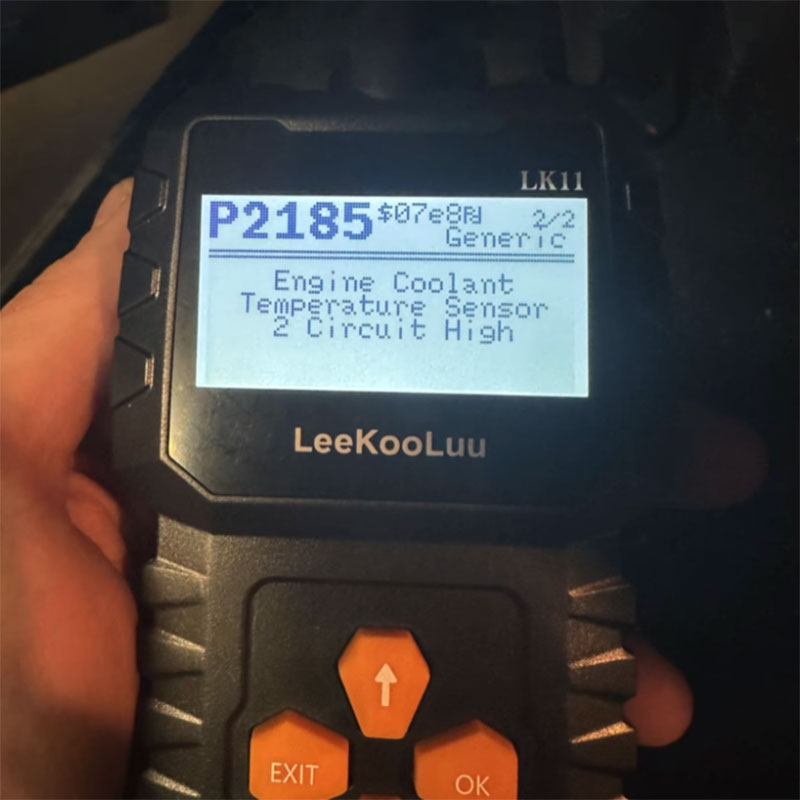What Does The 565e BMW Code Mean And How To Fix It?
The 565e Bmw Code indicates an issue with the oil pressure control, specifically related to the oil pump control circuit. Resolving this issue often involves diagnosing the oil pressure sensor or the oil pump itself, and AutoExplain.com can provide expert remote support. By understanding the causes and solutions, you can address oil pressure problems efficiently, preventing potential engine damage and ensuring optimal performance, utilizing the expertise of seasoned BMW technicians.
1. Understanding the 565E BMW Code
The 565E BMW code signals a problem within the oil pressure regulation system, often pinpointing issues in the oil pump control circuit, and diagnosing the cause is the first step toward resolution. This code indicates that the engine control unit (ECU) has detected a discrepancy in the oil pressure, potentially leading to engine damage if left unaddressed. Proper oil pressure is crucial for lubricating engine components, and any deviation from the optimal range can cause increased wear and tear.
1.1. What Does the 565E Code Really Mean?
The 565E code signifies that the Engine Control Unit (ECU) has detected an anomaly in the oil pressure control system. Specifically, it suggests a problem with the oil pump control circuit, leading to inadequate or excessive oil pressure within the engine. This can be triggered by a variety of factors, ranging from sensor malfunctions to issues with the oil pump itself.
1.2. Common Symptoms Associated with the 565E Code
Several symptoms can accompany the 565E code, providing valuable clues for diagnosing the underlying issue.
- Check Engine Light: Illumination of the check engine light is a primary indicator that something is amiss.
- Low Oil Pressure Warning: A low oil pressure warning on the dashboard is a critical sign that the engine is not receiving adequate lubrication.
- Engine Noise: Unusual engine noises, such as knocking or tapping, may occur due to insufficient lubrication.
- Reduced Engine Performance: The engine may exhibit reduced power and responsiveness.
- Engine Stalling: In severe cases, the engine may stall due to lack of proper lubrication.
- Oil Leaks: Inspect the engine area for any signs of oil leaks, which could contribute to low oil pressure.
1.3. How Serious Is The 565E Code?
The 565E code should be considered a serious issue. Operating a vehicle with abnormal oil pressure can lead to significant engine damage, including wear on critical components such as bearings, pistons, and crankshaft. Addressing this code promptly is essential to prevent costly repairs and maintain the engine’s longevity. Ignoring the 565E code can lead to catastrophic engine failure, necessitating complete engine replacement.
2. Potential Causes of the 565E BMW Code
Identifying the root cause of the 565E code is crucial for effective repair. Several factors can trigger this code, and a systematic approach to diagnosis is essential.
2.1. Faulty Oil Pressure Sensor
A malfunctioning oil pressure sensor can provide inaccurate readings to the ECU, triggering the 565E code. The sensor may be damaged, corroded, or simply worn out, leading to incorrect data transmission. A faulty sensor can lead to both false positives and false negatives, making it difficult to determine the actual oil pressure.
2.2. Wiring and Connection Issues
Damaged, corroded, or loose wiring and connections in the oil pressure sensor circuit can disrupt the signal flow to the ECU. These issues can result in intermittent or complete signal loss, leading to the 565E code. Inspecting the wiring harness and connectors for any signs of damage is crucial.
2.3. Problems with the Oil Pump
The oil pump is responsible for maintaining adequate oil pressure throughout the engine. A failing or worn-out oil pump may not be able to deliver the required oil flow, triggering the 565E code. Common issues include worn gears, internal leaks, and a clogged oil pump screen.
2.4. Low Oil Level or Quality
Insufficient oil levels or degraded oil quality can significantly impact oil pressure. Low oil levels reduce the amount of oil available for circulation, while contaminated or old oil can lose its lubricating properties. Regularly checking and maintaining the correct oil level and quality is essential for optimal engine performance.
2.5. Issues with the Oil Filter
A clogged or incorrect oil filter can restrict oil flow, leading to low oil pressure. A clogged filter increases the strain on the oil pump and reduces the amount of oil reaching critical engine components. Ensure the oil filter is replaced according to the manufacturer’s recommendations and that the correct type of filter is used.
2.6. ECU Malfunctions
In rare cases, the 565E code may be triggered by a malfunctioning ECU. Although less common, internal faults within the ECU can lead to incorrect interpretation of sensor data, resulting in false error codes. Ruling out other potential causes before suspecting the ECU is essential.
3. Diagnosing the 565E BMW Code: A Step-by-Step Guide
A systematic approach to diagnosing the 565E code can help pinpoint the underlying issue efficiently. Here’s a step-by-step guide to follow:
3.1. Initial Inspection
Begin with a thorough visual inspection of the engine compartment. Check for any obvious signs of damage, such as oil leaks, frayed wires, or corroded connectors. Ensure the oil level is within the recommended range and inspect the oil condition for any signs of contamination.
3.2. Using an OBD-II Scanner
Connect an OBD-II scanner to the vehicle’s diagnostic port to confirm the presence of the 565E code. Clear the code and then perform a test drive to see if it reappears. This helps determine if the issue is intermittent or persistent.
3.3. Testing the Oil Pressure Sensor
Use a multimeter to test the oil pressure sensor’s voltage and resistance. Compare the readings with the manufacturer’s specifications to determine if the sensor is functioning correctly. A faulty sensor will typically exhibit readings outside the specified range.
3.4. Checking Wiring and Connections
Inspect the wiring and connectors associated with the oil pressure sensor circuit. Look for any signs of damage, corrosion, or loose connections. Use a wiring diagram to trace the circuit and ensure continuity. Repair or replace any damaged wiring or connectors.
3.5. Evaluating Oil Pressure
Use a mechanical oil pressure gauge to measure the actual oil pressure at various engine speeds. Compare the readings with the manufacturer’s specifications to determine if the oil pressure is within the acceptable range. Low oil pressure indicates a potential issue with the oil pump or oil filter.
3.6. Inspecting the Oil Pump
If low oil pressure is confirmed, the oil pump should be inspected. This may involve removing the oil pan to access the pump. Check for any signs of wear, damage, or clogging. If the pump is found to be faulty, it should be replaced.
3.7. Assessing the Oil Filter
Remove and inspect the oil filter for any signs of clogging or contamination. A severely clogged filter can restrict oil flow and reduce oil pressure. Replace the filter with a new one of the correct type and specification.
3.8. Consulting with Professionals
If you are unsure about any of the diagnostic steps, consult with a professional mechanic or BMW technician. They have the expertise and tools necessary to accurately diagnose and repair complex issues. AutoExplain.com offers remote diagnostic services to assist with troubleshooting.
4. Repairing the 565E BMW Code
Once the underlying cause of the 565E code has been identified, the appropriate repair steps can be taken.
4.1. Replacing the Oil Pressure Sensor
If the oil pressure sensor is found to be faulty, it should be replaced with a new, genuine BMW sensor. Ensure the sensor is properly installed and torqued to the manufacturer’s specifications. After replacement, clear the 565E code and perform a test drive to verify the issue is resolved.
4.2. Repairing Wiring and Connections
Repair any damaged wiring or connectors in the oil pressure sensor circuit. Use appropriate repair techniques, such as soldering and heat-shrinking, to ensure a secure and reliable connection. Replace any severely damaged wiring harnesses.
4.3. Replacing the Oil Pump
If the oil pump is found to be faulty, it should be replaced with a new, genuine BMW oil pump. Ensure the pump is properly installed and primed before starting the engine. After replacement, verify that the oil pressure is within the specified range and clear the 565E code.
4.4. Changing the Oil and Filter
If low oil level or contaminated oil is suspected, perform an oil change using the correct type and viscosity of oil recommended by BMW. Replace the oil filter with a new, genuine BMW filter. Ensure the oil level is properly filled to the recommended mark.
4.5. Cleaning or Replacing the Oil Filter Housing
Inspect the oil filter housing for any signs of sludge or debris. Clean the housing thoroughly or replace it if necessary. Ensure the oil filter housing is properly sealed to prevent leaks.
4.6. Addressing ECU Issues
If an ECU malfunction is suspected, consult with a qualified ECU repair specialist. They can diagnose and repair internal ECU faults or recommend a replacement ECU if necessary.
5. Preventive Measures to Avoid the 565E BMW Code
Preventing the 565E code involves regular maintenance and proactive care of the engine’s oil system.
5.1. Regular Oil Changes
Adhere to the manufacturer’s recommended oil change intervals. Regular oil changes help maintain optimal oil quality and prevent the buildup of sludge and contaminants.
5.2. Using Quality Oil and Filters
Use high-quality, synthetic oil and genuine BMW oil filters. These components are designed to meet the specific requirements of BMW engines and provide superior protection.
5.3. Monitoring Oil Levels
Regularly check the engine oil level and top off as needed. Maintaining the correct oil level ensures adequate lubrication and prevents low oil pressure.
5.4. Inspecting for Leaks
Periodically inspect the engine for any signs of oil leaks. Addressing leaks promptly can prevent low oil levels and potential engine damage.
5.5. Professional Maintenance
Schedule regular maintenance appointments with a qualified mechanic or BMW technician. They can perform thorough inspections and identify potential issues before they escalate.
6. How AutoExplain.com Can Help
AutoExplain.com offers comprehensive support for diagnosing and resolving the 565E BMW code, including remote assistance from experienced BMW technicians. We can help you accurately diagnose the issue, provide step-by-step repair guidance, and offer expert advice to ensure the problem is resolved efficiently. Our services include:
6.1. Remote Diagnostic Assistance
Our team of experienced BMW technicians can provide remote diagnostic assistance using advanced diagnostic tools. We can help you interpret error codes, analyze sensor data, and pinpoint the underlying cause of the 565E code.
6.2. Step-by-Step Repair Guidance
We offer step-by-step repair guidance to help you perform the necessary repairs effectively. Our detailed instructions include diagrams, torque specifications, and other critical information to ensure the job is done correctly.
6.3. ECU Programming and Software Updates
If ECU programming or software updates are required, we can provide remote programming services to ensure your ECU is functioning optimally. Our programming services can address software glitches, improve engine performance, and resolve complex issues.
6.4. Expert Advice and Support
Our team of experts is available to answer your questions and provide expert advice throughout the repair process. We are committed to helping you resolve the 565E code and ensure your BMW is running smoothly.
This is an oil pressure sensor on a BMW engine. The oil pressure sensor is a critical component of the engine management system.
7. Addressing Related BMW Codes
While addressing the 565E code, it’s essential to be aware of other related BMW codes that may provide additional insights into the issue. Here are some codes often associated with oil pressure and engine performance:
7.1. 578E BMW Code
The 578E code, similar to 565E, often indicates issues with oil pressure regulation. It can be triggered by similar factors, such as a faulty oil pressure sensor, wiring issues, or problems with the oil pump. Addressing both codes together can provide a comprehensive solution.
7.2. 29E1 and 29E2 BMW Codes
These codes relate to fuel mixture adaptation. While not directly related to oil pressure, they can indicate broader engine performance issues that may be exacerbated by low oil pressure. Diagnosing these codes can help ensure the engine is running efficiently.
7.3. 2A82 BMW Code
The 2A82 code indicates a VANOS solenoid issue, which can affect engine timing and performance. Addressing this code ensures that the engine’s variable valve timing system is functioning correctly, optimizing performance and fuel efficiency.
7.4. 2A98 BMW Code
This code relates to crankshaft – camshaft correlation. Issues with oil pressure can indirectly affect the performance of the camshaft and crankshaft, leading to this code. Addressing oil pressure issues can help resolve 2A98.
8. Tools and Equipment Needed for Repair
Performing repairs related to the 565E code requires specific tools and equipment. Having the right tools on hand can make the repair process more efficient and effective.
8.1. OBD-II Scanner
An OBD-II scanner is essential for reading and clearing error codes. A quality scanner can provide detailed information about the code and related sensor data.
8.2. Multimeter
A multimeter is needed for testing the oil pressure sensor’s voltage and resistance. Ensure the multimeter is capable of measuring both AC and DC voltage, as well as resistance.
8.3. Mechanical Oil Pressure Gauge
A mechanical oil pressure gauge is used to measure the actual oil pressure at various engine speeds. This tool provides a more accurate reading than the sensor.
8.4. Socket Set and Wrenches
A comprehensive socket set and wrench set are necessary for removing and installing various engine components, such as the oil pressure sensor and oil pump.
8.5. Torque Wrench
A torque wrench is essential for tightening bolts and nuts to the manufacturer’s specified torque. Proper torque is crucial to prevent leaks and ensure components are securely fastened.
8.6. Wiring Repair Kit
A wiring repair kit includes tools and materials for repairing damaged wiring and connectors. This kit should include soldering equipment, heat shrink tubing, and various connectors.
8.7. Oil Filter Wrench
An oil filter wrench is needed for removing and installing the oil filter. Ensure the wrench is the correct size for the oil filter being used.
9. Understanding BMW’s Oil System
A deeper understanding of BMW’s oil system can help in diagnosing and resolving oil pressure-related issues.
9.1. Components of the Oil System
The oil system consists of several key components, including the oil pump, oil filter, oil pressure sensor, oil cooler (if equipped), and oil galleries. Each component plays a critical role in maintaining proper oil pressure and lubrication.
9.2. Oil Pump Function
The oil pump is responsible for circulating oil throughout the engine. It draws oil from the oil pan and pumps it through the oil filter and into the engine’s oil galleries. The oil pump is typically driven by the crankshaft or camshaft.
9.3. Oil Filter Function
The oil filter removes contaminants from the oil, preventing them from circulating through the engine and causing wear. A clean oil filter ensures that the oil reaching critical engine components is free of debris.
9.4. Oil Pressure Sensor Function
The oil pressure sensor monitors the oil pressure and provides feedback to the ECU. The ECU uses this information to adjust engine parameters and trigger warnings if the oil pressure falls outside the acceptable range.
9.5. Oil Cooler Function
Some BMW models are equipped with an oil cooler, which helps to dissipate heat from the oil. The oil cooler is typically located in the engine compartment and is connected to the oil system via hoses.
10. FAQ about the 565E BMW Code
Here are some frequently asked questions about the 565E BMW code, providing quick answers to common concerns.
10.1. Can I Drive My BMW with the 565E Code?
Driving with the 565E code is not recommended. Low oil pressure can lead to significant engine damage, so it’s best to address the issue as soon as possible.
10.2. How Much Does It Cost to Fix the 565E Code?
The cost to fix the 565E code can vary depending on the underlying cause. Replacing the oil pressure sensor may cost between $150 and $300, while replacing the oil pump can range from $500 to $1500.
10.3. Can Low Oil Level Cause the 565E Code?
Yes, low oil level can cause the 565E code. Insufficient oil levels can lead to low oil pressure, triggering the code.
10.4. Is It Possible to Fix the 565E Code Myself?
Yes, it is possible to fix the 565E code yourself if you have the necessary tools and mechanical skills. However, if you are unsure about any of the repair steps, it’s best to consult with a professional.
10.5. How Often Should I Check My BMW’s Oil Level?
You should check your BMW’s oil level at least once a month, or more frequently if you notice any signs of oil leaks.
10.6. What Type of Oil Should I Use in My BMW?
Use high-quality, synthetic oil that meets BMW’s specifications. Consult your owner’s manual for the recommended oil type and viscosity.
10.7. Can a Clogged Oil Filter Cause the 565E Code?
Yes, a clogged oil filter can restrict oil flow and lead to low oil pressure, triggering the 565E code.
10.8. How Do I Reset the Check Engine Light After Repairing the 565E Code?
You can reset the check engine light using an OBD-II scanner. Clear the error codes after performing the necessary repairs.
10.9. Can AutoExplain.com Help Me Diagnose the 565E Code Remotely?
Yes, AutoExplain.com offers remote diagnostic assistance for the 565E code. Our experienced BMW technicians can help you pinpoint the underlying cause of the issue and provide step-by-step repair guidance.
10.10. What Other Codes Might Be Related to the 565E Code?
Related codes may include 578E, 29E1, 29E2, 2A82, and 2A98. Addressing these codes can provide a comprehensive solution to engine performance issues.
Encountering the 565E BMW code can be concerning, but with the right knowledge and approach, it can be effectively diagnosed and resolved. By understanding the symptoms, potential causes, and repair steps, you can ensure your BMW’s engine remains in optimal condition. For expert assistance and remote diagnostic support, don’t hesitate to contact AutoExplain.com via WhatsApp at (+84)967469410 or email at [email protected]. Visit our office at 1500 N Grant ST Sten Denver, CO 80203 or explore our services on AutoExplain.com to keep your BMW running smoothly with professional diagnostic services and navigation updates.
65535 Audi Fault Code: Expert Solutions and Fixes
Audi A3 Trouble Code 00796: Diagnosis, Solutions, and Expert Insights
Audi DTC 16347:014 – Expert Diagnosis and Solutions

Josh William
Josh William is a seasoned automotive expert and technical writer at AutoExplain. With a background as an automotive technician, he brings hands-on experience and deep industry knowledge to his writing.





